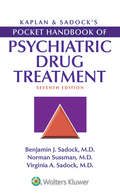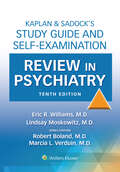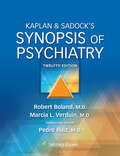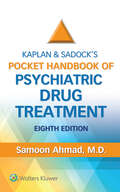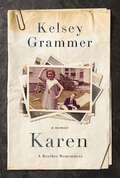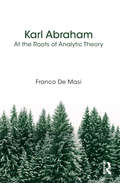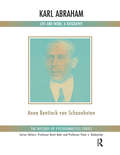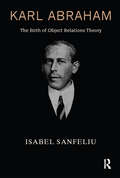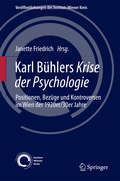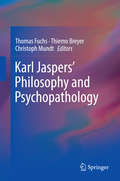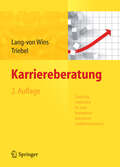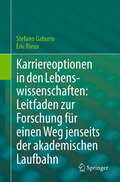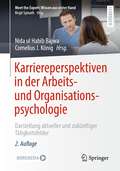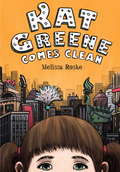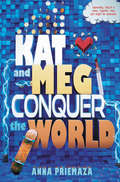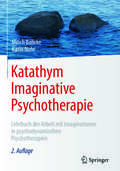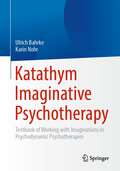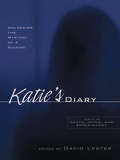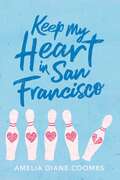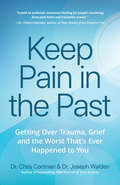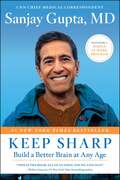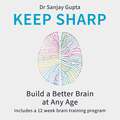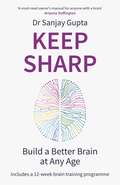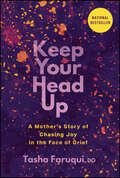- Table View
- List View
Kaplan & Sadock's Pocket Handbook of Clinical Psychiatry
by Benjamin J. Sadock Virginia A. SadockCompletely revised to bring you up to date with current DSM-5 classifications, new medications, and more, Kaplan & Sadock’s Pocket Handbook of Clinical Psychiatry, Sixth Edition, is a concise, easy-to-use guide to diagnosing the full range of psychiatric disorders in both adults and children. Brief summaries of psychiatric disorders include key aspects of etiology, epidemiology, clinical features, and suggestions for treatment. It’s an ideal ready reference for psychiatrists and other physicians, medical students on psychiatric rotations, psychiatric residents, and mental health professionals in psychology, social work, and nursing.
Kaplan & Sadock's Pocket Handbook of Psychiatric Drug Treatment
by Virginia A. Sadock Benjamin Sadock Norman SussmanFor nearly 25 years, Kaplan & Sadock's Pocket Handbook of Psychiatric Drug Treatment has been an authoritative source of up-to-date, easy-to-find information on the full spectrum of psychiatric drug therapy. Now fully revised, the Seventh Edition of this essential guide remains the drug reference of choice for psychiatrists and other physicians, as well as psychiatric residents, medical students, clinical psychologists, psychiatric nurses, and other professionals who provide care for the mentally ill.
Kaplan & Sadock’s Study Guide and Self-Examination Review in Psychiatry
by Eric R. Williams Robert Boland Lindsay Moskowitz Marcia L. VerduinPerfect for stand-alone review or as preparation for the USMLE, PRITE in-service, ABPN Part I, and recertification examinations,Kaplan and Sadock’s Study Guide and Self-Examination Review in Psychiatry, 10th Edition, is a comprehensive, authoritative review of the entire field. Written by Drs. Eric R. Williams and Lindsay Moskowitz, this essential review tool contains more than 600 multiple-choice questions and answers, with explanatory discussions of correct and incorrect responses.
Kaplan & Sadock’s Synopsis of Psychiatry
by Pedro Ruiz Robert Boland Marcia VerdiunAccurate, reliable, objective, and comprehensive, Kaplan & Sadock’s Synopsis of Psychiatry has long been the leading clinical psychiatric resource for clinicians, residents, students, and other health care professionals both in the US and worldwide. Now led by a new editorial team of Drs. Robert Boland and Marcia L. Verduin, it continues to offer a trusted overview of the entire field of psychiatry while bringing you up to date with current information on key topics and developments in this complex specialty. The twelfth edition has been completely reorganized to make it more useful and easier to navigate in today’s busy clinical settings.
Kaplan and Sadock's Pocket Handbook of Psychiatric Drug Treatment
by Samoon AhmadNow in vibrant full color, Kaplan and Sadock’s Pocket Handbook of Psychiatric Drug Treatment, 8th Edition, remains your reference of choice for easy-to-find information on the full spectrum of psychiatric drug therapies. Written by Dr. Samoon Ahmad, this trusted resource provides a wealth of data for each drug, presenting information in a clear, concise manner for quick, efficient retrieval. This edition brings you fully up to date in the field, with new information on cannabis, psychedelics, psychotropic medicines and medical comorbidities, genetics and pharmacogenomics testing, and more.
Karen: A Brother Remembers
by Kelsey Grammer“Grammer’s tender portrait of his sister as a sensitive, intelligent soul goes a long way toward correcting the record, and his vacillation between rawness and composure on the page is enormously affecting.” – Publishers Weekly <br> One of Oprah Daily’s Most Anticipated Books of 2025 <br> On July 1, 1975, Kelsey Grammer’s younger sister, eighteen-year-old Karen Grammer, was raped and murdered. In Karen, Kelsey reveals their past, celebrates their youth together, mourns her loss, and unearths his struggle for faith and healing in the decades since her death. <p> Karen by Kelsey Grammer delves into the tragic story of the author’s sister, Karen, who was brutally murdered at the age of eighteen. Kelsey was just twenty years old when his younger sister, a recent high school graduate, moved to Colorado Springs, where she was kidnapped by several men who had intended to rob the Red Lobster where she worked. They instead kidnapped Karen, raped her, and ultimately stabbed her to death. <p> Through this memoir, Grammer poignantly recounts the memories of his sister and the impact her loss had on his life and family. With raw honesty, Grammer explores the profound grief and devastation that followed Karen’s death, as well as the long and arduous journey toward healing. He bravely confronts the pain of losing a loved one to senseless violence, offering readers a glimpse into the complexities of coping with such a profound loss. <p> Karen also serves as a testament to Grammer’s lifelong journey with grief and his struggle to defeat the sting of death with the memory of a life filled with joy—irreplaceable joy. In sharing his story, Grammer aims to help others who have experienced similar loss, offering solace and encouragement to cherish the love they knew, however brief, on their own path toward healing. This book is a moving tribute to Karen and the brother’s love that survives her. <b>New York Times Bestseller</b>
Karl Abraham: At the Roots of Analytic Theory
by Franco De MasiThis book describes the life of Karl Abraham, his work in Zurich and Berlin, and his scientific relationship with Freud. Abraham wrote important papers which form the base of clinical psychoanalysis and analytic technique: transference, countertransference, narcissism, envy and childhood trauma. In particular, the book takes into account the contribution Abraham made to understanding the problem of mourning and melancholia, not only through his works dedicated to this topic but also with his contribution within the continuous and scientific communication with Freud, as documented in the Freud-Abraham correspondence (Karnac, 2002). In the final chapter, 'What Abraham could not understand', the book describes how, when Abraham read the manuscript of Mourning and Melancholia, he did not fully understand some passages of Freud's text. He thought for a long time until he could envisage a solution to an unsolved problem - that of the way in which the patient succeeds in overcoming the mourning. This happens when the loved and lost object is reinstalled in his inner world, a very important concept in the Kleinian development.
Karl Abraham: Life and Work, a Biography (The History of Psychoanalysis Series)
by Anna Bentinck van SchoonhetenThis book provides the reader with rich evidence of the very contemporaneity of Karl Abraham, reminding the reader of his unique clinical contributions to such diverse areas of concentration as the psychoses, depression, and the pre-oedipal.
Karl Abraham: The Birth of Object Relations Theory (Biblioteca Nueva Ser.)
by Isabel SanfeliuThis book provides an in-depth analysis of the major milestones in Karl Abraham's career, and highlights his interest in mythology and his permanent focus on the libido. It explores his development of two different forms of early object relations: incorporation and destruction.
Karl Bühlers Krise der Psychologie
by Janette FriedrichIm Mittelpunkt des Bandes steht Karl Bühlers 1927 veröffentlichte Schrift zur „Krise der Psychologie“. Bühler setzt sich darin mit den verschiedenen Ansätzen zur Erforschung psychologischer Phänomene auseinander. Seine Analyse der sich seit Ende des 19. Jahrhunderts als eigenständige Disziplin konstituierenden Psychologie nehmen die Autoren zum Ausgangspunkt, um die „Positionen, Bezüge und Kontroversen im Wien der 1920er/30er Jahre“ zu beleuchten. Dabei stellen sie bisher wenig beachtete theoretische Positionen Karl Bühlers vor und präsentieren neue historische Fakten zu seiner Schaffenszeit an der Wiener Universität.Die Themen der Beiträge reichen vom Neubeginn der Wiener Philosophie mit der Besetzung der drei Lehrstühle im Jahre 1922 über die Forschungen zum Film unter Leitung von Karl Bühler in den 1930er Jahren bis hin zu neuen Erkenntnissen der NS-Provenienzforschung zur Bibliothek von Karl und Charlotte Bühler. Die Verbindungen zwischen Bühlers Krisenanalyse und dem Forschungsprogramm der Brentanoschule werden aufgezeigt, sein Interesse am Medienbegriff des Psychologen Fritz Heider ebenso detailreich diskutiert wie Bühlers in den 1930er Jahren begonnenes Projekt einer Lebenspsychologie und einer Sematologie als allgemeine Zeichentheorie. Dabei beantworten die Autoren die Frage nach der Aktualität seines Denkens ganz unterschiedlich.Mit der Erschließung neuer Quellen und der Rekonstruktion historischer Kontexte sowie durch komparative Textstudien leisten die Autoren einen originellen Beitrag zur Wissenschaftsgeschichte, insbesondere zur Geschichte der Psychologie und der Philosophie wie auch zur Institutionsgeschichte der Wiener Universität am Anfang des 20. Jahrhunderts. Der Band richtet sich an Spezialisten auf diesen Gebieten, aber auch an Psychologen, Sprachwissenschaftler, Erziehungswissenschaftler und Philosophen.
Karl Jaspers' Philosophy and Psychopathology
by Thomas Fuchs Thiemo Breyer Christoph MundtThis book is based on a congress evaluating Jaspers' basic psychopathological concepts and their anthropological roots in light of modern research paradigms. It provides a definition of delusion, his concept of "limit situation" so much challenged by trauma research, and his methodological debate. We are approaching the anniversary of Jaspers seminal work General Psychopathology in 1913. The Centre of Psychosocial Medicine of the University with its Psychiatric Hospital where Jaspers wrote this influential volume as a 29 year old clinical assistant hosted a number of international experts familiar with his psychiatric and philosophical work. This fruitful interdisciplinary discussion seems particularly important in light of the renewed interest in Jaspers' work, which will presumably increase towards the anniversary year 2013. This volume is unique in bringing together the knowledge of leading international scholars and combining three dimensions of investigation that are necessary to understand Jaspers in light of contemporary questions: history (section I), methodology (section II) and application (section III).
Karriereberatung. Coachingmethoden für eine kompetenzorientierte Laufbahnberatung
by Thomas Lang-von Wins Claas TriebelDer Wandel von der stabilen Erwerbsbiografie zur instabilen Patchworklaufbahn verlangt von Karriere- und Berufsberatern eine besondere Herangehensweise. Die Autoren stellen Coaching-Methoden vor, die Personen in beruflichen Umbruchsituationen bei der aktiven Gestaltung des Berufswegs helfen und vorhandene Ressourcen aktivieren. Praxisnah und direkt einsetzbar beschrieben, können die wissenschaftlich fundierten Verfahren auf zahlreichen Feldern eingesetzt werden: von der Beratung Jugendlicher bis zum Coaching von Fach- und Führungskräften.
Karriereoptionen in den Lebenswissenschaften: Leitfaden zur Forschung für einen Weg jenseits der akademischen Laufbahn
by Stefano Gaburro Eric RieuxDieser praktische Leitfaden zeigt alternative Karrieremöglichkeiten für Forscher in den Lebenswissenschaften jenseits der akademischen Laufbahn auf. Verfasst von aktiven Fachleuten mit praktischer Erfahrung bietet das Buch einen umfassenden Überblick über nicht-akademische Rollen und die vielen verfügbaren Karrierewege. In unserer Ausbildung in den Lebenswissenschaften durchlaufen viele von uns eine klassische akademische Ausbildung, die uns auf die Durchführung von universitärer Forschung vorbereitet. Allerdings landen nur 20-30 % der Studierenden in festen akademischen Positionen. Der Rest verlässt das Feld aufgrund der herausfordernden Bedingungen und fehlender gesicherter Anstellung. Da sich das Gebiet weiterhin ausdehnt und diversifiziert, wachsen auch die Chancen für die berufliche Entwicklung außerhalb der traditionellen Wege. Es gibt eine steigende Nachfrage nach qualifizierten Experten, um verschiedene Stellen in der Industrie, der Regierung und anderen Sektoren zu besetzen. Hier finden Sie Anleitungen, wie Sie Ihre wissenschaftliche Erfahrung optimal nutzen können, um in den verschiedenen Rollen erfolgreich zu sein. Darüber hinaus wird die Vorbereitung Ihres Lebenslaufs (CV), Anschreibens und Ihrer sozialen Medien (LinkedIn) behandelt. Interviews mit ausgewählten Persönlichkeiten aus verschiedenen Bereichen bieten einzigartige Einblicke in Lebenswege mit echtem praktischem Bezug. Schließlich berät dieses Werk Universitäten und akademische Einrichtungen, wie ein entsprechendes Bildungsmodell in ihre Lehrpläne integriert werden könnte, um zukünftigen Absolventen der Lebenswissenschaften ein umfassendes Spektrum ihrer Möglichkeiten zu bieten.
Karriereperspektiven in der Arbeits- und Organisationspsychologie: Darstellung aktueller und zukünftiger Tätigkeitsfelder (Meet the Expert: Wissen aus erster Hand)
by Nida ul Habib Bajwa Cornelius J. KönigDieses Buch bietet Studienanfängern sowie Abiturienten, die sich für die Arbeits- und Organisationspsychologie interessieren, Einblicke in die vielfältigen Berufsfelder des Fachgebiets. Die Arbeits- und Organisationspsychologie hat sich in den letzten Jahrzehnten in Deutschland sehr gut etabliert, sowohl innerhalb der Psychologie als auch in der Wirtschaft. Es ist nach der klinischen Psychologie das zweitwichtigste Anwendungsfach der Psychologie. So richten sich über 30% aller ausgeschriebenen Arbeitsstellen für Psychologen an Psychologie-Absolventen mit einem Schwerpunkt in der Arbeits- und Organisationspsychologie. Experten aus der Praxis stellen in diesem Band sehr anschaulich Ihren Berufsalltag dar, schildern ihre persönlichen Werdegänge und zeigen mögliche Karriereperspektiven für angehende Arbeits-, Organisations- und Wirtschaftspsychologen auf. Dadurch gibt dieses Werk eine wertvolle Orientierung und erleichtert den Entscheidungsprozess. Kurze Video-Clips aus den Experteninterviews bereichern den Inhalt durch zusätzlichen Nutzen.
Kat Greene Comes Clean
by Melissa RoskeKat Greene lives in New York City and attends fifth grade in the very progressive Village Humanity School. At the moment she has three major problems—dealing with her boy-crazy best friend, partnering with the overzealous Sam in the class production of Harriet the Spy, and coping with her mother's preoccupation with cleanliness, a symptom of her worsening obsessive-compulsive disorder.
Kat and Meg Conquer the World
by Anna PriemazaFor fans of Nicola Yoon’s Everything, Everything, Emery Lord’s When We Collided, and Rainbow Rowell’s Fangirl, Anna Priemaza’s debut novel is a heartwarming and achingly real story of finding a friend, being a fan, and defining your place in a difficult world.Kat and Meg couldn’t be more different. Kat’s anxiety makes it hard for her to talk to people. Meg hates being alone, but her ADHD keeps pushing people away. But when the two girls are thrown together for a year-long science project, they discover they do have one thing in common: They’re both obsessed with the same online gaming star and his hilarious videos.It might be the beginning of a beautiful friendship—if they don’t kill each other first. “Kat and Meg Conquer the World will hit home for anyone who has ever been waist-deep in fandom, doubt, or new relationships; Kat’s and Meg’s unique voices are outstanding, and their friendship brings this story to vibrant life."—Francesca Zappia, author of Made You Up and Eliza and Her Monsters
Katathym Imaginative Psychotherapie: Lehrbuch der Arbeit mit Imaginationen in psychodynamischen Psychotherapien (Psychotherapie: Praxis)
by Ulrich Bahrke Karin NohrDr. Bahrke und Dr. Nohr stellen in diesem Buch Psychotherapeuten und Psychoanalytikern vor, wie sie mit der Katathym Imaginativen Psychotherapie (KIP) auf dem heutigen Stand psychodynamischer Erkenntnisse arbeiten können. Die Methode ist eine von Hanscarl Leuner unter dem Namen „Katathymes Bilderleben“ 1955 eingeführte und seither weiterentwickelte Methode der psychodynamischen Psychotherapie. Anschaulich in Fallbeispielen und übersichtlich in einer systematischen Darstellung zeigen die Autoren den State of the Art.Über die Methode: Wie arbeitet KIP? Die therapeutische Praxis beruht auf der Einbeziehung von Imaginationen in den Therapieprozess. Unbewusste Wünsche, Konflikte, deren Abwehr sowie die Übertragungsbeziehung werden so symbolhaft veranschaulicht. Die vom Therapeuten angeregten und begleiteten Imaginationen ergänzen auf wertvolle Weise den psychodynamischen Verstehensprozess und eröffnen zusätzlich zum Gespräch einen affektnahen, motivationsfördernden Zugangsweg bei der Bearbeitung vieler Störungsbilder in Kurz- und Langzeittherapien. Im Gegensatz zu anderen Imaginationen nutzenden Psychotherapiemethoden werden die Imaginationen in der KIP unter Beachtung von Übertragung und Widerstand als Bestandteil der Beziehungsarbeit verstanden.Geschrieben für ... psychodynamisch arbeitende Psychotherapeuten, Psychiater und Psychoanalytiker, die mit Imaginationen arbeiten, sowie alle an Bildsprache, Metaphern und Träumen interessierten Kollegen.
Katathym Imaginative Psychotherapy: Textbook of Working with Imaginations in Psychodynamic Psychotherapies
by Ulrich Bahrke Karin NohrIn this book, Dr. Bahrke and Dr. Nohr introduce psychotherapists and psychoanalysts to how they can work with Katathym Imaginative Psychotherapy (KIP) at the current level of psychodynamic knowledge. The method is a method of psychodynamic psychotherapy introduced by Hanscarl Leuner in 1955 under the name "Katathymes Bilderleben" and further developed since then. The authors clearly show the state of the art in case studies and in a systematic presentation. About the method: How does KIP work? The therapeutic practice is based on the inclusion of imaginations in the therapy process. Unconscious desires, conflicts, their defense as well as the transference relationship are thus symbolically illustrated. The imaginations stimulated and accompanied by the therapist are a valuable supplement to the psychodynamic process of understanding and, in addition to conversation, open up an affect-related, motivation-promoting access route in the treatment of many disturbance patterns in short and long-term therapies. In contrast to other psychotherapy methods that use imaginations, imaginations in KIP are understood as a component of relational work, taking transference and resistance into account. Written for ... Psychodynamically working psychotherapists, psychiatrists and psychoanalysts who work with imaginations, as well as all colleagues interested in figurative language, metaphors and dreams.
Katie's Diary: Unlocking the Mystery of a Suicide (Series in Death, Dying, and Bereavement)
by David LesterKatie's Diary is a unique analysis of the diary left behind by a young woman who has committed suicide. As compared to suicide notes, which are typically brief, Katie's diary consists of five separate books, an opportunity to look into the mind of a suicide from a source of data that is extraordinarily rare. Commenting on the diary are professionals in the fields of suicidology, linguistics, women's studies, Jungian analysis and voice therapy, among others. Suicidal themes that prevail in her writing are discussed, as well as potential treatment methods in the hopes that the study will contribute to suicide prevention.
Keep My Heart in San Francisco
by Amelia Diane CoombsSparks fly when two ex-best-friends team up to save a family business in this swoon-worthy and witty debut perfect for fans of Jenn Bennett and Sarah Dessen.Caroline &“Chuck&” Wilson has big plans for spring break—hit up estate sales to score vintage fashion finds and tour the fashion school she dreams of attending. But her dad wrecks those plans when he asks her to spend vacation working the counter at Bigmouth&’s Bowl, her family&’s failing bowling alley. Making things astronomically worse, Chuck finds out her dad is way behind on back rent—meaning they might be losing Bigmouth&’s, the only thing keeping Chuck&’s family in San Francisco. And the one person other than Chuck who wants to do anything about it? Beckett Porter, her annoyingly attractive ex-best friend. So when Beckett propositions Chuck with a plan to make serious cash infiltrating the Bay Area action bowling scene, she accepts. But she can&’t shake the nagging feeling that she&’s acting irrational—too much like her mother for comfort. Plus, despite her best efforts to keep things strictly business, Beckett&’s charm is winning her back over...in ways that go beyond friendship. If Chuck fails, Bigmouth&’s Bowl and their San Francisco legacy are gone forever. But if she succeeds, she might just get everything she ever wanted.
Keep Pain in the Past: Getting Over Trauma, Grief and the Worst That's Ever Happened to You
by Dr. Joseph Walden Dr. Christopher CortmanHeal your psychological pain and take back your life with this breakthrough process based on decades of successful treatment.In Keep Pain in the Past, two of America’s top psychologists in the field of emotional trauma and PTSD share their highly effective methodology for recovering from painful psychological wounds. Whether it’s extreme trauma such as sexual abuse, the horrors of war, or the very serious pain of loss, grief, shame and guilt, their method can help you recover without years of intensive therapy.Doctors Christ Cortman and Joseph Walden have been helping patients recover from trauma for decades. Through a combination of practical steps and illuminating stories, they share the tools and techniques that can help you identify and face your pain, find closure, and alleviate related issues such as depression, anxiety, panic attacks, sleep disruption, and more.Discover how Sheri, a thirty-seven-year-old attorney, recovered from panic attacks that seemed to come out of nowhere. Follow the journey of Mark, a twenty-nine-year-old Army veteran, as he healed from a destructive downward spiral in the grip of PTSD. Explore how Melinda, a forty-two-year-old professor who struggled to sustain a romantic relationship, confronted her torturous childhood and finally found love. These and other stories demonstrate the restorative power of Keep Pain in the Past.
Keep Sharp: Build a Better Brain at Any Age
by Sanjay GuptaKeep your brain young, healthy, and sharp with this science-driven guide to protecting your mind from decline by neurosurgeon and CNN chief medical correspondent Dr. Sanjay Gupta.Throughout our life, we look for ways to keep our minds sharp and effortlessly productive. Now, globetrotting neurosurgeon Dr. Sanjay Gupta offers &“the book all of us need, young and old&” (Walter Isaacson, #1 New York Times bestselling author of The Code Breaker) with insights from top scientists all over the world, whose cutting-edge research can help you heighten and protect brain function and maintain cognitive health at any age. Keep Sharp debunks common myths about aging and mental decline, explores whether there&’s a &“best&” diet or exercise regimen for the brain, and explains whether it&’s healthier to play video games that test memory and processing speed, or to engage in more social interaction. Discover what we can learn from &“super-brained&” people who are in their eighties and nineties with no signs of slowing down—and whether there are truly any benefits to drugs, supplements, and vitamins. Dr. Gupta also addresses brain disease, particularly Alzheimer&’s, answers all your questions about the signs and symptoms, and shows how to ward against it and stay healthy while caring for a partner in cognitive decline. He likewise provides you with a personalized twelve-week program featuring practical strategies to strengthen your brain every day. Keep Sharp is the &“must-read owner&’s manual&” (Arianna Huffington) you&’ll need to keep your brain young and healthy regardless of your age!
Keep Sharp: Build a Better Brain at Any Age - As Seen in The Daily Mail
by Dr Sanjay GuptaAn exciting new science-driven guide to protecting your mind from decline. Throughout our lives, we are always looking for ways to keep our mind sharp and effortlessly productive. In this book, globetrotting neurosurgeon Dr Sanjay Gupta offers insights from top scientists all over the world, whose cutting edge research can help you heighten and protect brain function and maintain cognitive health at any age. Keep Sharp debunks common myths about ageing and cognitive decline, explores whether there's a 'best' diet or exercise regimen for the brain, and explains whether it's healthier to play video games that test memory and processing speed, or to engage in more social interaction. Discover what we can learn from 'super-brained' people who are in their eighties and nineties but showing no signs of slowing down - and whether there are truly any benefits to drugs, supplements and vitamins. Dr Gupta also addresses brain disease, particularly Alzheimer's, answers all your questions about signs and symptoms, and shows you both how to ward against it and how to care for a partner in cognitive decline. The book also provides readers with a personalized twelve-week programme featuring practical strategies to strengthen your brain every day. Keep Sharp is the only owner's manual you'll need to keep your brain young and healthy at any age!(P)2021 Simon & Schuster
Keep Sharp: How To Build a Better Brain at Any Age - As Seen in The Daily Mail
by Dr Sanjay GuptaAn exciting new science-driven guide to protecting your mind from decline.'Fascinating' Daily MailThroughout our lives, we are always looking for ways to keep our mind sharp and effortlessly productive. In this book, globetrotting neurosurgeon Dr Sanjay Gupta offers insights from top scientists all over the world, whose cutting edge research can help you heighten and protect brain function and maintain cognitive health at any age. Keep Sharp debunks common myths about ageing and cognitive decline, explores whether there's a 'best' diet or exercise regimen for the brain, and explains whether it's healthier to play video games that test memory and processing speed, or to engage in more social interaction. Discover what we can learn from 'super-brained' people who are in their eighties and nineties but showing no signs of slowing down - and whether there are truly any benefits to drugs, supplements and vitamins. Dr Gupta also addresses brain disease, particularly Alzheimer's, answers all your questions about signs and symptoms, and shows you both how to ward against it and how to care for a partner in cognitive decline. The book also provides readers with a personalized twelve-week programme featuring practical strategies to strengthen your brain every day. Keep Sharp is the only owner's manual you'll need to keep your brain young and healthy at any age!
Keep Your Head Up: A Mother's Story of Chasing Joy in the Face of Grief
by Tasha FaruquiA testament to the depth of familial love and our ability to endure in the face of childhood terminal illness Keep Your Head Up is the incredible tale of one family's path to perseverance in the face of devastating odds. When author Tasha Faruqui gave birth to her second daughter, Soraya, she knew immediately that something was wrong. Yet as years passed and every medical test for Soraya came back normal or inconclusive, Tasha began to realize that science doesn't always have the answers, and there are some issues in life that simply cannot be fixed. Yet, we can continue to find happy moments and celebrate the beauty of what we have. This story gives a voice to parents and loved ones of terminally ill children, illuminating the way to comfort, community, and unbreakable hope. This book discusses terminal illness with raw honesty, demonstrating how families can provide transparency to life-limited children around a terminal diagnosis, comfort them when they are afraid of what comes next, and continue to embrace life despite ongoing challenges. With beautiful narration and a heartfelt perspective, Keep Your Head Up testifies to the true depth of familial love and the hard things we can endure with grace and resilience. This book: Provides guidance, hope, and understanding to parents and caregivers of terminally ill children Tells a story that will resonate with families facing elusive diagnoses, fickle healthcare systems, and emotional turmoil Offers hope that it is possible to find joy in the face of tragedy and give sick children the gift of a fully lived life Presents the balanced and relatable perspective of an award-winning pediatrician and parent to a child in hospice Parents, family, and friends of terminally ill children, as well as healthcare professionals and educators, will appreciate Keep Your Head Up for its candor and its value as a guide to moving through a situation no family should have to face.

